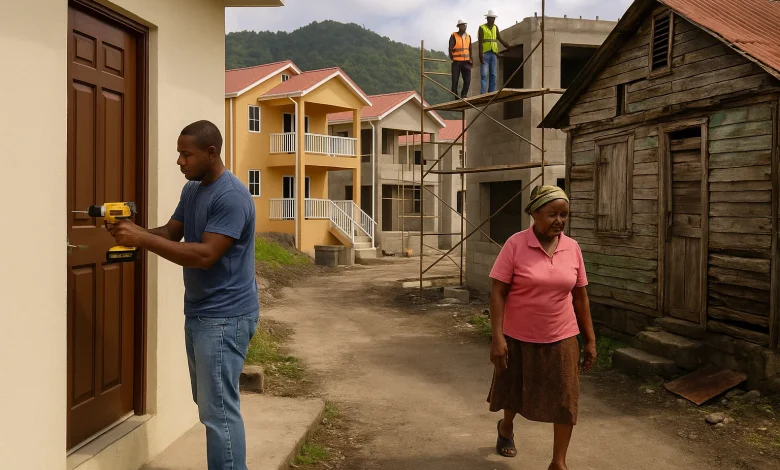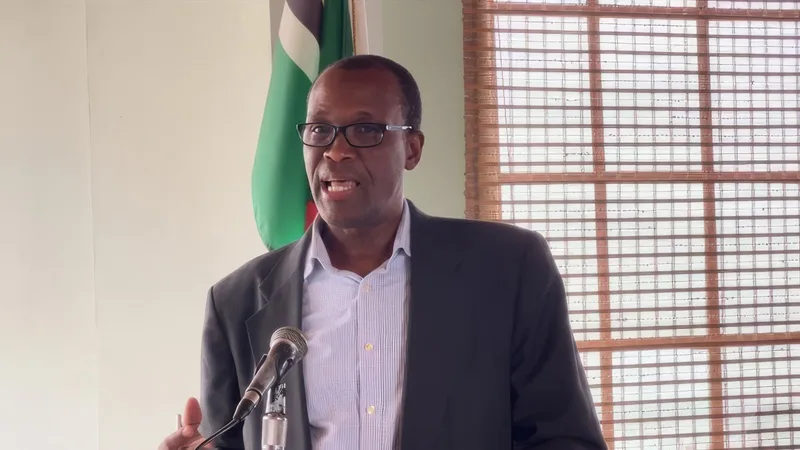Housing Industry & Sector in Dominica

The housing sector in Dominica has been reshaped by two powerful forces: decades of policy choices that favored community-level services and hazard-aware planning, and the shock of extreme weather events that damaged or destroyed large portions of the national housing stock. Since Tropical Storm Erika in 2015 and Hurricane Maria in 2017, the country has moved from emergency sheltering to structured reconstruction programs, stronger building standards, pooled procurement for materials, and new public financing tools. A combination of government projects, World Bank support, regional partnerships, and private contractors has produced new settlements, thousands of roof repairs, and a growing pipeline of climate-resilient homes. The state continues to anchor housing policy while engaging international lenders and developers to expand supply, modernize codes, and target the most vulnerable households.
Pre-Maria baseline and damage profile
Before Maria, most homes in Dominica were self-built or incrementally improved over time, often with mixed levels of code compliance. Post-disaster assessments after Maria surveyed roughly 24,300 houses. About 13,500 needed minor to moderate repairs and approximately 10,800 required full roof reconstruction or equivalent major works. This quantified the scale of need and justified a national program that could channel public finance and technical assistance into household-level reconstruction with resilient standards.
The storms did not affect communities evenly. Coastal and ridge-top dwellings saw extreme wind loads, while river valleys experienced debris flows and flooding. The village of Petite Savanne had been devastated earlier by Tropical Storm Erika, triggering a permanent resettlement plan that later produced a planned community at Bellevue Chopin.
Policy direction and institutions
Housing policy is coordinated by the Ministry with responsibility for housing and lands, working alongside the Physical Planning Division, and project implementation units created for donor-funded programs. Physical Planning administers development control and code compliance, supporting the broader policy goal of resilient land use and safer structures. These agencies translate national resilience objectives into development permits, inspections, and site approvals.
The national resilience agenda is set out in the Climate Resilience and Recovery Plan 2020–2030. Target outcomes include raising the share of housing stock that meets resilient building codes to very high levels, shortening the time it takes households to return to basic living standards, and aligning infrastructure with hazard maps. This planning framework gives the housing sector clear performance goals across the decade.
Key Figures and Data in Dominica’s Housing Sector
Reliable numbers anchor housing policy and investment. The dataset below captures stock, damage, reconstruction outputs, budgets, and targets across Dominica’s housing sector, you can compare progress, identify gaps, and calibrate future delivery.
Census and baseline stock
- Population: The 2011 Population and Housing Census recorded a non-institutional population of 70,739.
- Households: The same census tabulations report 25,113 households islandwide, with details on dwelling type, lighting and utilities.
- Coverage: The census achieved 92.5% coverage of actively occupied dwellings, excluding closed and vacant units.
Maria impact and macro losses
- Damage share: The Post-Disaster Needs Assessment (PDNA) found housing bore the largest share of sectoral damage at 38% of total damages.
- Stock affected: About 90% of the housing stock sustained damage.
- Overall losses: Total damages were EC$2.51 billion (US$930.9 million) and losses EC$1.03 billion (US$380.2 million), equal to 226% of 2016 GDP.
Early shelter outputs and unit costs
- Emergency sheltering: Humanitarian shelter operations after Maria targeted 13,039 households and 38,117 individuals across 12 locations.
- Repairs and cores: A published case study documents 670 roof repairs and 80 core houses delivered to Dominican standards. Average project cost was US$4,666 per household, with indicative unit costs of US$3,700 per roof and US$6,182 per core house.
Housing Recovery Project (World Bank)
- Financing envelope: The Housing Recovery Project totals about US$41.6 million, with components for systems and capacity (US$3.5 m), reconstruction (US$27.7 m), project management (US$3 m), and a contingent emergency response (US$7.43 m).
- Scope and standards: The project focuses on in-situ reconstruction of destroyed homes to meet Category 5-resistant standards and to improve approval processes and uptake of resilient practices.
- Delivery partners and reach: Technical partners report the housing system has processed applications from 3,000+ families and is rebuilding 400+ homes, with a management information system supporting case flow.
- Audited execution: Independent financial statements confirm ongoing disbursements and component restructuring, including activation of the CERC in 2020 without additional funding.
Investment signals and affordability indicators
- Targeted outputs: Policy documents note construction of nearly 1,000 new homes financed through CBI in a recent year, within a broader target of 5,000 resilient units.
- Typical costs: Comparative resilient-housing studies show that preventive retrofits are markedly less expensive than post-disaster rebuilding, with average improvement costs significantly lower than new construction. While not Dominica-specific, these ratios guide budget planning.
Taken together, these figures show significant strides in resilient construction and resettlement while emphasising continuing needs for finance, enforcement, and wide-scale retrofits to harden existing homes across all districts.
Building standards and code enforcement
Dominica’s move toward stronger, hazard-aware building has been supported by technical partners that produce practical guides and training materials. For example, guidance on roof geometry, fastening schedules, and hurricane straps helps reduce uplift failures that were common during past storms. Regional and global assessments note that many Caribbean states, including Dominica, have adopted improved codes but must continue to strengthen inspection capacity and enforcement to realize the full safety benefits. Practical enforcement, contractor training, and homeowner education remain priority areas.
Major public programs and financing
Major public programs and financing in Dominica’s housing sector combine international loans, national initiatives, and donor support, focusing on rebuilding resilient homes, resettlement schemes, and sustainable financing models to address storm damage and housing vulnerability.
Housing Recovery Project (World Bank)
The flagship Housing Recovery Project (HRP) was approved by the World Bank to help households affected by Hurricane Maria rebuild with resilient standards. The program finances reconstruction grants, technical assistance, and supervision to ensure safer designs. The HRP’s development objective is to contribute to the recovery of housing for Maria-affected households and improve the application of resilient practices in the housing sector. Approval documents and later policy notes place the original financing envelope at about US$40 million, with the program designed as a multi-year effort.
Implementation partners include international non-profits and engineering groups that provide design support, quality control, and beneficiary outreach. Some partners note a program design that envisioned support for a large caseload of vulnerable households, including many whose homes were entirely destroyed. HRP communications frequently stress that the value is not only in numbers built but in the diffusion of better construction practices across the entire market.
Government resettlement and new communities
For communities deemed unsafe or impractical to rebuild in place, the government executed resettlement projects. The Petite Savanne Resettlement at Bellevue Chopin delivered 353 residential units along with community amenities, completed and handed over in phases through 2019. Earlier announcements and contractor disclosures described a pipeline of staged handovers that ultimately reached the 353-unit mark for this site. This project created a modern, serviced neighborhood with stronger wind resistance, improved site drainage, and public spaces.
Housing Revolution and CBI-financed construction
Alongside donor-financed work, the government launched a Housing Revolution program that channeled domestic resources and Citizenship by Investment (CBI) revenue into climate-resilient apartments and homes across multiple localities. Industry coverage referenced a multi-year ambition to deliver several thousand units and supporting public infrastructure, with continuing handovers in communities such as Eggleston and Scotts Head. Program narratives highlight reinforced concrete structures, improved roofing systems, and utility networks designed for high wind speeds and heavy rainfall.
In areas with distinct cultural heritage and land tenure systems, such as the Kalinago Territory, recovery partners supported a combined approach: new homes, plus training to build local skills for safe construction and maintenance. Reporting from the government noted that hundreds of homes were delivered through a mix of World Bank, European Union, and other programs, along with training modules that helped households understand hazard-safe methods.
Supply Chain, Construction Capacity and Affordability
One of the sector’s constraints has been the availability of materials and trained crews during peak reconstruction periods. Import logistics, port capacity, and regional competition for roofing sheets, hurricane ties, and cement can produce periodic delays. Pooled procurement approaches for public projects and standardized designs reduce cost and speed delivery, but small builders still face price volatility. Regional experience shows that where inspection regimes are predictable and installment payments are tied to passed inspections, private builders adopt safer practices more quickly.
Post-disaster housing needs intersect with household incomes and land security. Programs therefore use eligibility criteria to prioritize low-income and vulnerable households for grants or subsidized units. Resettlement schemes address safety in high-risk zones but also require solutions for livelihoods and social networks. Efforts to regularize tenure, discourage squatting in hazard-prone areas, and integrate basic services so that new housing sites are not isolated. These actions reduce future losses and help stabilize neighborhoods created under the program umbrella.
Public administration and planning
Effective housing delivery requires coordination among permitting authorities, project units, social services, and local councils. The Physical Planning Division provides the regulatory backbone for development control. At the program level, project management units handle procurement, contracting, and monitoring, while social teams verify eligibility and support beneficiary choices. Lessons learned since 2017 include the importance of field engineers embedded in districts, community meetings that explain resilient details in plain language, and clear helplines for homeowners navigating grants.
Climate resilience targets and design choices
Resilient housing in Dominica is not a slogan; it is expressed through specific design features that reduce failure under wind and rain. Technical guides emphasize hip roofs or adequately braced gable roofs, correct spacing and length of nails or screws, hurricane straps at every truss-to-wall connection, ring beams that tie walls together, and shutters or impact-rated glazing. Siting decisions consider slope stability, drainage paths, and river setbacks. The national resilience plan aims to raise the share of compliant homes and to shorten recovery times after shocks, using targets that are easy to monitor over the plan period.
Different implementers cite different metrics depending on funding windows and scopes. The World Bank’s HRP focuses on households supported with grants that meet resilient standards, while resettlement sites report number of keys handed over and community facilities completed. One high-profile resettlement delivered 353 units; other program channels report hundreds of additional homes built or repaired and a pipeline of thousands targeted with CBI funding across the island. The combined effect has been to replace total losses, upgrade damaged structures, and push resilient techniques into the private market through visibility and supervision.
Land-use Considerations and the Role of Development Partners
Relocating households out of high-risk zones, especially areas exposed to debris flows and landslides, reduces future casualties and economic losses. After Erika, national authorities decided that some locations were simply too dangerous to rebuild, prompting permanent resettlement and new site development with services. On rivers and coastal margins, stricter development control and better drainage design reduce the chance that a single rain event undoes years of progress. Disaster risk is integrated into subdivision approvals, with Physical Planning charged to review site plans against hazard information.
International finance and technical assistance have been central. The World Bank financed HRP and broader disaster-resilience investments; the European Union and other partners supported housing and critical infrastructure; humanitarian agencies assisted in the immediate aftermath of storms; specialized NGOs offered design and supervision tools. Policy documents from international financial institutions also connect housing to macro-fiscal strategies, recognizing that resilient homes reduce public relief spending, protect human capital, and speed economic recovery after storms.
Persistent challenges
Despite visible progress, several constraints persist:
- Enforcement capacity. Codes on paper only save lives when inspection is consistent, contractors are trained, and non-compliant work is halted. Region-wide analyses show that building code enforcement is still catching up with modern standards, so training and institutional support remain vital.
- Cost and affordability. Imported materials, transport to remote sites, and topography raise construction costs. Grant programs lower barriers for the poorest, but middle-income households may still under-invest in tie-downs or proper fasteners when budgets are tight.
- Land tenure. Clarifying titles or providing legal alternatives for households on family land helps programs disburse grants faster and reduces future disputes.
- Skilled labor. Demand for masons, carpenters, roofers, and site supervisors peaks after disasters. Training pipelines and certification programs can reduce bottlenecks and improve quality.
- Maintenance. Even a well-built roof requires periodic inspection and upkeep. Programs now include homeowner education so that small fixes are made before the next hurricane season.
What the next phase looks like
The next phase of housing policy is likely to deepen three strands. First, continued construction of climate-resilient units in targeted communities, with an emphasis on compact neighborhood planning, drainage, and public amenities. Second, household-level retrofits at scale, so existing homes receive bracing, straps, and corrected roof geometries. Third, digital tools that link permits, inspections, and grant disbursements, improving transparency and shortening timelines. The policy framework that guides these strands is already articulated in the national resilience plan through targets for housing stock compliance and rapid recovery after shocks.
Case snapshots
Bellevue Chopin (Petite Savanne resettlement). A master-planned community produced 353 units with markets and recreational fields. The development is an example of full resettlement from a no-build zone to a serviced site, combining housing with town-like amenities.
Ongoing apartment schemes under the Housing Revolution. Government updates and industry coverage describe handovers in multiple communities, with reinforced concrete frames, integrated utilities, and hazard-rated roofing systems. These demonstrate how CBI resources have been directed into public goods that reduce risk.
HRP design and training. Partners that specialize in safer construction have provided field manuals, contractor coaching, and homeowner support so that grant-built houses meet uplift and shear resistance targets. This work spreads knowledge beyond HRP beneficiaries into the broader building market.
Practical guidance for households and builders
Public guides emphasize a few steps that dramatically improve performance in high winds: continuous load paths from roof to foundation; hip roofs or properly braced gables; ring beams; correct nail or screw patterns; corrosion-resistant fasteners; and window and door protection. For sites on slopes or near waterways, simple changes to drainage, surface roughness, and retaining features reduce the risk of scour and slides. Many failures in past events were progressive: a mis-nailed ridge cap or missing strap allowed uplift to begin, then the entire roof peeled off. Checklists and illustrated manuals now help builders avoid these weaknesses.
Toward a Safer and Sustainable Housing Future
Looking ahead, the sector will likely combine public finance for new construction and retrofits with tighter inspections and better homeowner support. The most resilient neighborhoods will be those where codes are followed, stormwater is managed at the subdivision scale, and families understand how to maintain their homes season by season. With HRP maturing, resettlement sites occupied, and national plans pointing to clear targets, Dominica’s housing system is steadily gaining the capacity to withstand stronger storms and to recover with less disruption to family life and local economies.




